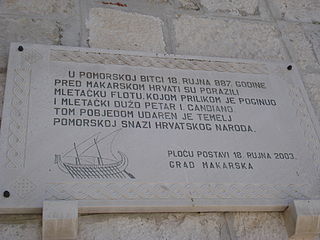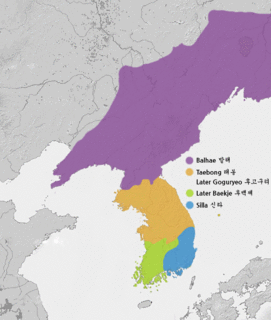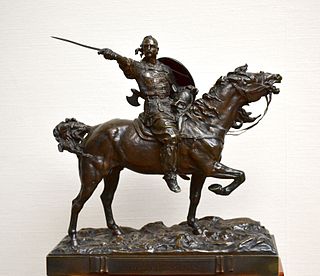 W
WBetween 780–1180, the Byzantine Empire and the Abbasid & Fatimid caliphates in the regions of Iraq, Palestine, Syria, Anatolia and Southern Italy fought a series of wars for supremacy in the Eastern Mediterranean. After a period of indecisive and slow border warfare, a string of almost unbroken Byzantine victories in the late 10th and early 11th centuries allowed three Byzantine Emperors, namely Nikephoros II Phokas, John I Tzimiskes and finally Basil II to recapture territory lost to the Muslim conquests in the 7th century Arab–Byzantine wars under the failing Heraclian Dynasty.
 W
WThe Croatian–Bulgarian Wars were a series of conflicts that erupted three times during the 9th and 10th centuries between the medieval realms of Croatia and Bulgaria. During these wars, Croatia formed alliances with Eastern Francia and Byzantium against the Bulgarian Empire.
 W
WThe Croatian–Venetian wars were a series of periodical, punctuated medieval conflicts and naval campaigns waged for control of the northeastern coast of the Adriatic Sea between the City-state of Venice and the Principality of Croatia, at times allied with neighbouring territories – the Principality of the Narentines and Zahumlje in the south and Istrian peninsula in the north. First struggles occurred at the very beginning of the existence of two conflict parties, they intensified in the 9th century, lessened during the 10th century, but intensified again since the beginning of the 11th century.
 W
WAccording to the dubious Chronicle of the Priest of Duklja, a Magyar leader named Kisa led an invasion into Bosnia, where he was decisively defeated by Časlav, the Prince of Serbia, somewhere on the Drina. Kisa's widow requested from the Magyar chief to give her another army to avenge his death. With an "unknown number" of troops, the widow went for Časlav, encountering him somewhere in Syrmia. In the night, the Magyars attacked the Serbs, captured Časlav and all of his male relatives. On the command of the widow, all of them were bound by their hands and feet and thrown into the Sava river. Vladimir Ćorović dates this event to c. 960.
 W
WThe Era of Fragmentation was an era of disunity in Tibetan history lasting from the death of the Tibetan Empire's last emperor, Langdarma, in 842 until Drogön Chögyal Phagpa gained control over the three provinces of Tibet in 1253. During this period, the political unity of the Tibetan Empire collapsed following a civil war between Yumtän and Ösung (’Od-srung), after which followed numerous rebellions against the remnants of imperial Tibet and the rise of regional warlords.
 W
WThe Five Dynasties and Ten Kingdoms period (907–979) was an era of political upheaval and division in 10th-century Imperial China. Five states quickly succeeded one another in the Central Plain, and more than a dozen concurrent states were established elsewhere, mainly in South China. It was the last prolonged period of multiple political divisions in Chinese imperial history.
 W
WThe history of Islam in Sicily and Southern Italy began with the first Arab settlement in Sicily, at Mazara, which was captured in 827. The subsequent rule of Sicily and Malta started in the 10th century. The Emirate of Sicily lasted from 831 until 1061, and controlled the whole island by 902. Though Sicily was the primary Muslim stronghold in Italy, some temporary footholds, the most substantial of which was the port city of Bari, were established on the mainland peninsula, especially in mainland Southern Italy, though Muslim raids, mainly those of Muhammad I ibn al-Aghlab, reached as far north as Naples, Rome and the northern region of Piedmont. The Muslim raids were part of a larger struggle for power in Italy and Europe, with Christian Byzantine, Frankish, Norman and local Italian forces also competing for control. Muslims were sometimes sought as allies by various Christian factions against other factions.
 W
WThe battle of Kandalur salai, also spelled Kanthaloor shala, was a naval engagement of the Cholas under Rajaraja I against the "salai" at Kandalur in south Kerala. The exact location of Kandalur—somewhere south Kerala—is a subject of scholarly debate. The above event is sometimes assumed to be identical with the "conquest of Vizhinjam by a general of Rajaraja", before the burning of Lanka, given in the Tiruvalangadu Grant/Plates.
 W
WThe Later Three Kingdoms of Korea (892–936) consisted of Silla, Hubaekje and Hugoguryeo. The latter two claimed heirs to the earlier Three Kingdoms of Korea, which had been united by Silla. This period arose out of national unrest during the reign of Queen Jinseong of Silla, and usually refers to the era between the founding of Hubaekje by Gyeon Hwon to the time Goryeo unified the peninsula.
 W
WSviatoslav I Igorevich, also spelled Svyatoslav, was a Grand Prince of Kiev famous for his persistent campaigns in the east and south, which precipitated the collapse of two great powers of Eastern Europe, Khazaria and the First Bulgarian Empire. He also conquered numerous East Slavic tribes, defeated the Alans and attacked the Volga Bulgars, and at times was allied with the Pechenegs and Magyars.
 W
WThe Tripartite Struggle for control of northern India took place in the ninth century. The struggle was between the Pratihara Empire, the Pala Empire and the Rashtrakuta Empire.